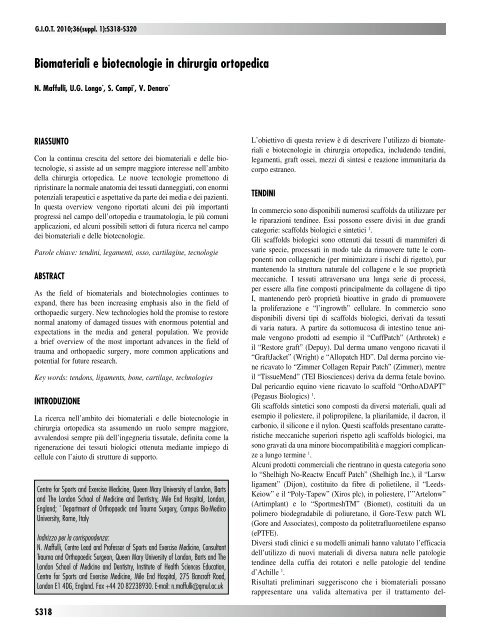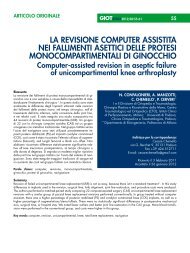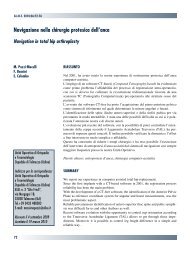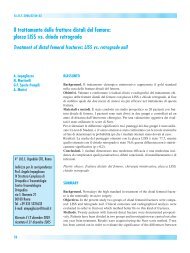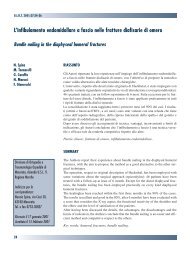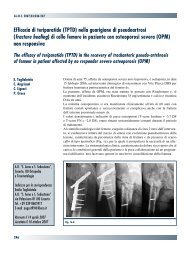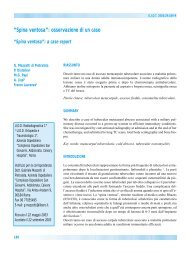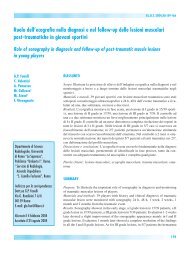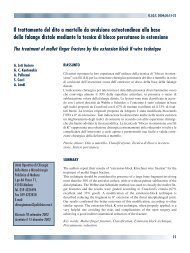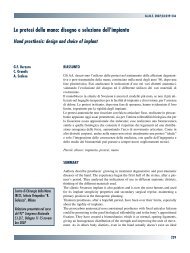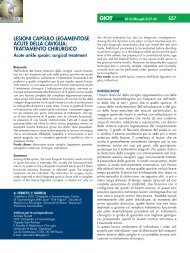30845 Suppl Giot.pdf - Giornale Italiano di Ortopedia e Traumatologia
30845 Suppl Giot.pdf - Giornale Italiano di Ortopedia e Traumatologia
30845 Suppl Giot.pdf - Giornale Italiano di Ortopedia e Traumatologia
You also want an ePaper? Increase the reach of your titles
YUMPU automatically turns print PDFs into web optimized ePapers that Google loves.
G.I.O.T. 2010;36(suppl. 1):S318-S320<br />
Biomateriali e biotecnologie in chirurgia ortope<strong>di</strong>ca<br />
N. Maffulli, u.G. Longo * , S. Campi * , V. Denaro *<br />
rIaSSuNTO<br />
Con la continua crescita del settore dei biomateriali e delle biotecnologie,<br />
si assiste ad un sempre maggiore interesse nell’ambito<br />
della chirurgia ortope<strong>di</strong>ca. Le nuove tecnologie promettono <strong>di</strong><br />
ripristinare la normale anatomia dei tessuti danneggiati, con enormi<br />
potenziali terapeutici e aspettative da parte dei me<strong>di</strong>a e dei pazienti.<br />
In questa overview vengono riportati alcuni dei più importanti<br />
progressi nel campo dell’ortope<strong>di</strong>a e traumatologia, le più comuni<br />
applicazioni, ed alcuni possibili settori <strong>di</strong> futura ricerca nel campo<br />
dei biomateriali e delle biotecnologie.<br />
Parole chiave: ten<strong>di</strong>ni, legamenti, osso, cartilagine, tecnologie<br />
aBSTraCT<br />
As the field of biomaterials and biotechnologies continues to<br />
expand, there has been increasing emphasis also in the field of<br />
orthopae<strong>di</strong>c surgery. New technologies hold the promise to restore<br />
normal anatomy of damaged tissues with enormous potential and<br />
expectations in the me<strong>di</strong>a and general population. We provide<br />
a brief overview of the most important advances in the field of<br />
trauma and orthopae<strong>di</strong>c surgery, more common applications and<br />
potential for future research.<br />
Key words: tendons, ligaments, bone, cartilage, technologies<br />
INTrODuzIONE<br />
La ricerca nell’ambito dei biomateriali e delle biotecnologie in<br />
chirurgia ortope<strong>di</strong>ca sta assumendo un ruolo sempre maggiore,<br />
avvalendosi sempre più dell’ingegneria tissutale, definita come la<br />
rigenerazione dei tessuti biologici ottenuta me<strong>di</strong>ante impiego <strong>di</strong><br />
cellule con l’aiuto <strong>di</strong> strutture <strong>di</strong> supporto.<br />
Centre for Sports and Exercise Me<strong>di</strong>cine, Queen Mary University of London, Barts<br />
and The London School of Me<strong>di</strong>cine and Dentistry, Mile End Hospital, London,<br />
England; * Department of Orthopae<strong>di</strong>c and Trauma Surgery, Campus Bio-Me<strong>di</strong>co<br />
University, Rome, Italy<br />
In<strong>di</strong>rizzo per la corrispondenza:<br />
N. Maffulli, Centre Lead and Professor of Sports and Exercise Me<strong>di</strong>cine, Consultant<br />
Trauma and Orthopae<strong>di</strong>c Surgeon, Queen Mary University of London, Barts and The<br />
London School of Me<strong>di</strong>cine and Dentistry, Institute of Health Sciences Education,<br />
Centre for Sports and Exercise Me<strong>di</strong>cine, Mile End Hospital, 275 Bancroft Road,<br />
London E1 4DG, England. Fax +44 20 82238930. E-mail: n.maffulli@qmul.ac.uk<br />
S318<br />
L’obiettivo <strong>di</strong> questa review è <strong>di</strong> descrivere l’utilizzo <strong>di</strong> biomateriali<br />
e biotecnologie in chirurgia ortope<strong>di</strong>ca, includendo ten<strong>di</strong>ni,<br />
legamenti, graft ossei, mezzi <strong>di</strong> sintesi e reazione immunitaria da<br />
corpo estraneo.<br />
TENDINI<br />
In commercio sono <strong>di</strong>sponibili numerosi scaffolds da utilizzare per<br />
le riparazioni ten<strong>di</strong>nee. Essi possono essere <strong>di</strong>visi in due gran<strong>di</strong><br />
categorie: scaffolds biologici e sintetici 1 .<br />
Gli scaffolds biologici sono ottenuti dai tessuti <strong>di</strong> mammiferi <strong>di</strong><br />
varie specie, processati in modo tale da rimuovere tutte le componenti<br />
non collageniche (per minimizzare i rischi <strong>di</strong> rigetto), pur<br />
mantenendo la struttura naturale del collagene e le sue proprietà<br />
meccaniche. I tessuti attraversano una lunga serie <strong>di</strong> processi,<br />
per essere alla fine composti principalmente da collagene <strong>di</strong> tipo<br />
I, mantenendo però proprietà bioattive in grado <strong>di</strong> promuovere<br />
la proliferazione e “l’ingrowth” cellulare. In commercio sono<br />
<strong>di</strong>sponibili <strong>di</strong>versi tipi <strong>di</strong> scaffolds biologici, derivati da tessuti<br />
<strong>di</strong> varia natura. A partire da sottomucosa <strong>di</strong> intestino tenue animale<br />
vengono prodotti ad esempio il “CuffPatch” (Arthrotek) e<br />
il “Restore graft” (Depuy). Dal derma umano vengono ricavati il<br />
“GraftJacket” (Wright) e “Allopatch HD”. Dal derma porcino viene<br />
ricavato lo “Zimmer Collagen Repair Patch” (Zimmer), mentre<br />
il “TissueMend” (TEI Biosciences) deriva da derma fetale bovino.<br />
Dal pericar<strong>di</strong>o equino viene ricavato lo scaffold “OrthoADAPT”<br />
(Pegasus Biologics) 1 .<br />
Gli scaffolds sintetici sono composti da <strong>di</strong>versi materiali, quali ad<br />
esempio il poliestere, il polipropilene, la pliarilamide, il dacron, il<br />
carbonio, il silicone e il nylon. Questi scaffolds presentano caratteristiche<br />
meccaniche superiori rispetto agli scaffolds biologici, ma<br />
sono gravati da una minore biocompatibilità e maggiori complicanze<br />
a lungo termine 1 .<br />
Alcuni prodotti commerciali che rientrano in questa categoria sono<br />
lo “Shelhigh No-Reactw Encuff Patch” (Shelhigh Inc.), il “Larsw<br />
ligament” (Dijon), costituito da fibre <strong>di</strong> polietilene, il “Leeds-<br />
Keiow” e il “Poly-Tapew” (Xiros plc), in poliestere, l’”Artelonw”<br />
(Artimplant) e lo “SportmeshTM” (Biomet), costituiti da un<br />
polimero biodegradabile <strong>di</strong> poliuretano, il Gore-Texw patch WL<br />
(Gore and Associates), composto da politetrafluoroetilene espanso<br />
(ePTFE).<br />
Diversi stu<strong>di</strong> clinici e su modelli animali hanno valutato l’efficacia<br />
dell’utilizzo <strong>di</strong> nuovi materiali <strong>di</strong> <strong>di</strong>versa natura nelle patologie<br />
ten<strong>di</strong>nee della cuffia dei rotatori e nelle patologie del ten<strong>di</strong>ne<br />
d’Achille 1 .<br />
Risultati preliminari suggeriscono che i biomateriali possano<br />
rappresentare una valida alternativa per il trattamento del-


